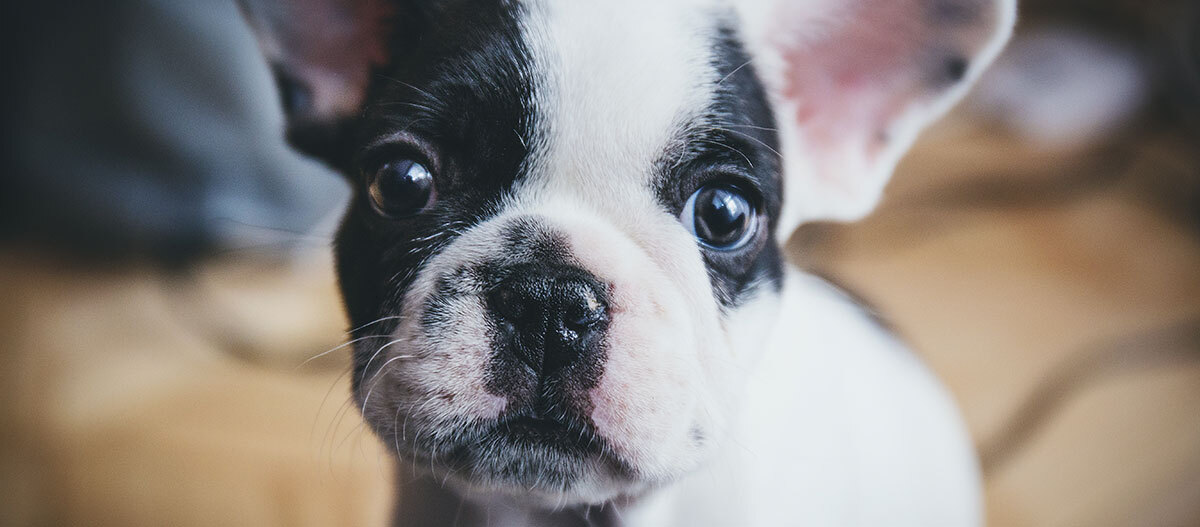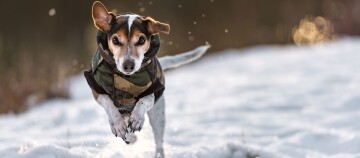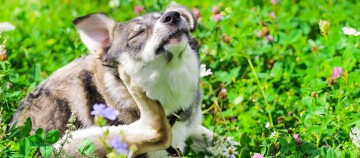French Bulldogs – from rat killer to family dog
27.02.2024 - Reading time: 10 minutes

The French Bulldog has been one of the most popular dog breeds there is for some time now. And it’s no wonder, as few can escape their charm and playful nature. Thanks to their even-tempered character, “Frenchies” are ideal for urban living, as long as you can satisfy their need for exercise. Unfortunately, the demand for popular breeds often goes hand in hand with neglect by breeders, which has led to breathlessness in many French bulldogs. Here, you can read all the important information you need to know about this intelligent dog full of personality.
- Origins in the working class
- French Bulldog colours and size
- French Bulldog profile
- Temperament and nature: How dangerous is a French Bulldog?
- Are French Bulldogs difficult to train?
- Buying a French Bulldog: What do I need to know?
- French Bulldogs with a nose
- How long does it take for a French Bulldog to grow up?
- How much does it cost to buy a French Bulldog puppy?
- The right diet for French Bulldogs
- Care tips for the French Bulldog
- Important note about the French Bulldog breed
Origins in the working class
Like pugs and French mastiffs, French bulldogs are part of the Molosser family. Their English ancestors were bred for bloody dogfights until these were banned in the 19th century. As a companion of British textile immigrant workers, bulldogs found their way to France and started out there as typical worker, carriage and butchers’ dogs, whose task was to catch rats. This led to cross-breeding with local pugs, spitzes and terriers. The look of the modern French Bulldog is based on this colourful mix of breeds, and this soon made the mini powerhouse popular in other classes of society and artistic circles. From then on, the breed became increasingly popular among the wealthy and noble people of society. In 1880, the first breed association was founded in Paris and a systematic breeding standard was developed. At the start of the 20th century, the Fédération Cynologique International (FCI) was founded, which classifies dog breeds into different groups. French bulldogs fall into FCI Group 9 “Companion and toy dogs”. The Pug and the Cavalier King Charles Spaniel are also part of this FCI group.
French Bulldog colours and size
The French Bulldog comes in a diverse range of colours: spotted, with or without brindle, from an even tawn to shades such as milk coffee or red. According to the breed guidelines, colours such as black with red “markings” and for example, brown, blue or grey French Bulldogs are undesired. Due to the dilution of the black, the dogs appear blue, but are actually grey. However, this colour is banned in many breeds, as in some circumstances, they can suffer from what is known as colour dilution alopecia. This illness can cause the dogs affected to lose all of their fur. Grown French Bulldogs reach a shoulder height of up to 35 centimetres and a weight of 8 to 14 kilograms. In general, female dogs are usually somewhat smaller and lighter than males.
NewsletterFrench Bulldog
Breed | French Bulldog |
Origin | France |
Classification | Society and companion dog |
Size | Up to 35 centimetres at shoulder height |
Weight | 8 to 14 kilograms |
Physique | Compact, muscular, agile, “square” head with short nose and muzzle, twisted tail |
Eyes | Slightly protruding |
Ears | Upright bat ears |
Coat and colour | Fine, short, even fawn in all shades, brindled, tabby; undesired colours: mouse grey, brown and black with red blaze |
Special features | Sensitive to high temperatures and cold, afraid of water |
Nature | Intelligent, playful, cuddly, good-natured, balanced and brave |
Care | Brushing, special care needed for ears, eyes and skin folds |
Health | Sensitive eyes and eye folds, tendency towards food allergies, short of breath |
Find the best products for your French bulldog here!
Temperament and nature: How dangerous is a French Bulldog?
Characteristic bat ears, wrinkly forehead and hanging flews: Even the French variant of the bulldog looks a little fierce. But this impression is deceiving. The French Bulldog has a balanced and good-natured temperament, but also one that is lively and stubborn. The attentive and loyal French bulldog is an ideal companion and loves to be close to its owners. It is devoted, cuddly and is good with children. A direct family connection is a must, with the dog not suitable for kennel living. Instead, it prefers to sleep next to (or directly in) the bed – while snoring at the same time. French Bulldogs are good guard dogs, but only have little motivation to hunt. They are also loveable and easy when it comes to interacting with strangers and other animals. In terms of character, French Bulldogs are true happy souls that need a loving hand, establish strong contacts to people and will gladly adapt to the family living routine. They are not considered dangerous and are therefore not designated as fighting dogs or listed as dangerous breeds.
Are French Bulldogs difficult to train?
Looking after French Bulldogs is easy even for first-time dog owners. The French Bulldog is therefore ideal as an apartment dog due to its size and affable qualities. But it should be kept from climbing the stairs excessively. Nevertheless, the animal needs plenty of room and activity. Just make sure that the dog does not wear itself out from sudden exuberance. When raising a French Bulldog, there are no breed-specific difficulties to be aware of – apart from the fact that it’s hard not to get sucked into the dog’s charm. Consistency in training is a must to ensure that the dog accepts you as an alpha animal. French Bulldogs are quick and eager to learn, and are very concerned with pleasing their owners. So be generous with praise!
Due to their lively nature, French Bulldogs love to run around and play, but given the breed-related breathlessness, they should not be overexhausted. They are not born athletes and are not suitable for performance sports such as cycling or jogging. The nose, which has been bred to be short, can result in overexertion with breathing problems, and the dog can no longer regulate its body temperature through panting and is at risk of overheating. The French Bulldog should therefore retreat rather to a shady spot during high temperatures in summer and not continually run around and play with the children in the garden. At any rate, dogs of this breed are not known for being good swimmers. Their short legs and relatively large head are not the best conditions for this. Despite this, French Bulldogs love water and enjoy small paddling pools in summer for cooling off.
But all this does not mean that these lively powerhouses are unable to enjoy moderate canine sports. Dog dancing, agility or tracking are all sports that allow the French bulldog to really work itself out. Here, fun and games take priority, not enduring performance.

Buying a French Bulldog: What do I need to know?
Due to their loving nature, French Bulldogs are excellent for families with children and singles in city apartments alike, as well as active, older people. To protect their joints, however, the dogs with their short legs must not run up and down stairs too much. A building with a lift or a ground floor apartment are ideal. The animals have a life expectancy of around 12 years. Before buying, consider whether you can offer the dog a good home for this time, even if your circumstances change.
If you want to buy a French Bulldog, it’s important to find a reputable breeder that exclusively breeds from healthy parents, socialises the animals with loving care right from the start and is available to answer your questions even after buying. Even if they take a closer look at you as a new owner, this is always a good sign, as ultimately, they are looking for the best home for their puppies. Before buying a French Bulldog puppy, you can usually visit it at the breeder’s several times before finally taking it home.
French Bulldogs with a nose
If you want to buy a French Bulldog from a breeder, it is essential that both the parents and the puppy are able to breathe freely. Make sure that the French Bulldog was born with a longer nose. For “fashion” reasons, this has been bred to be ever smaller, leading to breathing problems and health-related consequences for the animal. If the nose is too short, for example, the dog is unable to regulate its body temperature through its breathing. This is due to the fact that the mucous membranes are not cooled down because of the short nose. In addition, an excessively long soft palate and constricted nostrils make breathing difficult. If faced with a lot of heat or effort, there is therefore a risk of life-threatening heatstroke. In French Bulldogs, the anatomy of the air pipes may cause these to collapse if overexerted (known as tracheal collapse). This results in shortness of breath, which can quickly become dangerous for the dog. You should also look for a longer nose if you want to buy a French Bulldog mix.
How long does it take for a French Bulldog to grow up?
Compared to the English Bulldog, the French Bulldog is a rather small dog breed and is usually fully grown at around a year old. It then weighs between 8 and 14 kilograms and reaches a shoulder height of up to 35 centimetres.
How much does it cost to buy a French Bulldog puppy?
It is difficult to name one sole price for a French Bulldog. The price depends, among other things, on the respective breeder and can vary according to demand.
The right diet for French Bulldogs
With its short legs and compact physical build, the small and powerful dog breed tends to become overweight. Plenty of exercise and wholesome dog food with a high meat content are therefore a basic requirement for an active and vital life. Any switch to a different dog food should take place gradually, as French Bulldogs often tend to experience bloating and stomach problems on account of their breed. What’s more, when it comes to treats and small snacks for in-between, you should opt for low-fat products. Rabbits’ ears and cows’ ears are ideal and also clean the teeth.
Care tips for the French Bulldog
Taking care of the fur of the short-haired dog is very easy, but the French Bulldog is sensitive to cold and wet. Like with other dogs with skin folds, it is important to care for the face carefully and to keep the forehead folds clean and soft to prevent inflammations. One known health issue: French Bulldogs tend to suffer from food allergies. It’s therefore very important to pay attention to your furry friend’s diet and what its food contains. Make sure to buy your French Bulldog from a breeder that pays special attention to breeding-related hereditary diseases. In this dog breed, the ears and eyes are affected more commonly than in other breeds. Due to the flat face shape, large bat ears and adorable button eyes, these areas require more attention. The best way to do this is to check the ears every day and clean them as needed. In particular, the fold underneath the lid must always be kept dry, as it provides the ideal breeding ground for bacteria and triggers for inflammation.
Important note about the French Bulldog breed
The ‘Qualzuchtgutachten’ (expert report on breeding resulting in animal suffering), which was commissioned by the German government in 1999 in collaboration with the German Animal Welfare Federation, recommends a ban on the breeding of hairless breeds, extremely flat-faced breeds (brachycephalic breeds) and others in which extreme physical features (very long back, severely bent legs, spinal abnormalities, excessive fur growth, etc.) make it impossible for them to lead a healthy life.
As a responsible pet owner, who naturally cares greatly about ensuring that your four-legged friend can live a healthy, unimpaired life, this information should definitely be taken into account when deciding which breed is suitable for you, just as you would consider their excellent character traits.


